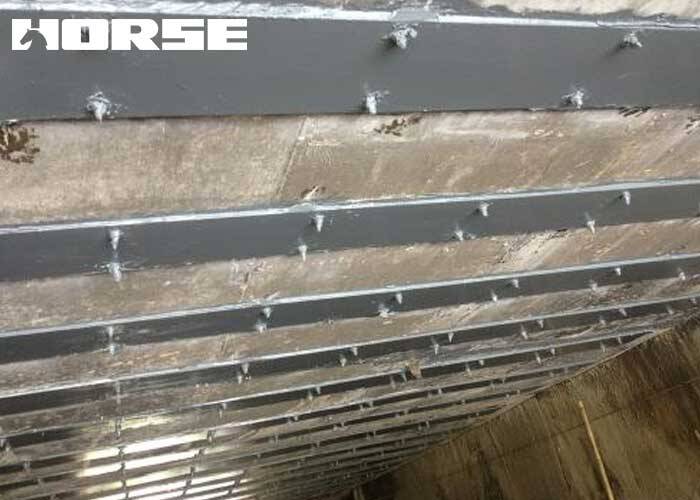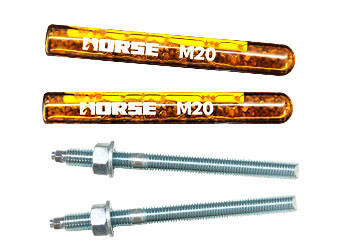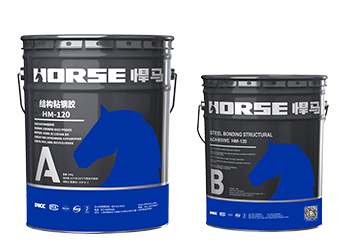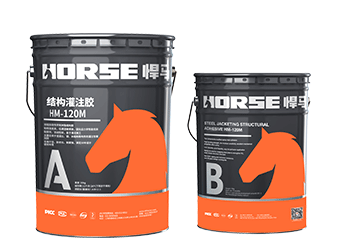Solutions
Horse Construction offers full range of structural strengthening materials with technical supports, documentation supports, products supports, project supports.
Mechanism and Application of Bonding Steel Method to Strengthen Bridges

An overview of the sticking steel plate reinforcement method
The sticking steel plate reinforcement method is to stick the steel plate on the surface of the concrete with a specially made adhesive material to improve the bearing capacity of the concrete. The application of steel plate in concrete is equivalent to adding a part of steel reinforcement, and compared with steel reinforcement, it has many advantages such as light weight, high strength, economical expenditure and simple construction. It is a more commonly used bridge reinforcement method. In addition, the sticking steel plate reinforcement method may also cause certain damage to the bridge body, so in the construction process of the project, we must pay attention to the construction operation specifications.
Mechanical properties and reinforcement mechanism
1) The bonded structural beam is damaged
The sticking steel plate reinforcement method has incomparable advantages over other methods. Due to various reasons, when the bonded steel plate is damaged, the steel plate bonded to the bottom of the beam can adapt to the change of yield and reach the yield strength. Within a certain load range, as the load increases, the original steel bars in the bridge yield, and the steel plates also reach a yielding state. The subsequent change is that the concrete is destroyed and crushed. In addition, there are tests that prove that the steel plate at the bottom of the beam has not reached the yield strength. What happens is that the shear between the steel plate and the concrete becomes larger, causing damage to the solid beam. This kind of damage occurs suddenly, because the bond between the steel plate and the concrete is suddenly torn off, the steel is subjected to a sudden increase in pressure, and the brittle failure occurs suddenly in the strengthening process.
2) Stress analysis of bonded steel beams
The stress condition of the bonded steel reinforced beam is more special than other stress conditions. When analyzing it, it is found that the reinforced beam steel plate has a stress hysteresis compared to the steel. Therefore, the steel plate can reach the yield when it is damaged by external force. Therefore, the reasons for the failure of the reinforced beam due to external force are as follows:
2.1) The anchorage length is not enough.
The tensile force of the steel plate only relies on the bonding stress on one side to maintain the balance, but the resultant force and the bonding stress of the steel plate are not in a straight line, but form a couple of forces, which deform the steel plate. Therefore, to keep the original shape, the length of the anchor should be increased.
2.2) There is a problem with the quality of the adhesive.
The strength of the bonding force between the steel plate and the concrete is also an important aspect of strengthening the beam, so a good bonding agent should be selected. Different manufacturers have different workmanship, and of course the adhesives produced are also different. Poor quality will cause the steel plate to tear off. Therefore, there should be a test when buying a binder, and the strength index of the test binder should not be lower than the strength of the concrete to effectively prevent damage to the reinforced beam. In order to prevent adhesive quality problems, relevant investigations must be done before purchase to ensure that the mixture will not affect the function of the steel plate.
2.3) There is a problem with the construction quality.
Reinforced beam damage and construction quality are inseparable. The bonding treatment of the reinforcing member and the bonding of the steel plate are extremely critical. When sticking and fixing and pressing, the sticking should be strong, otherwise it is easy to be peeled off by force, so the construction party must carefully stick the steel reinforcement. The construction quality is directly related to the functional restoration of the bridge after repair. If the construction quality is not good enough, it will not only not help the damage of the bridge, but will also increase the damage of the bridge. Therefore, the construction quality is particularly important. It is necessary to select a team with rich experience and good construction technology to repair the bridge.
The basic situation of this project
This overpass has four floors with a total length of 3660.9m. There are a total of 18 bridges, including two mainline bridges. Through the analysis of this overpass, it is found that the main line bridge mainly has some problems such as longitudinal cracks in the bottom plate of some large slab girder, large area exposure of the steel bar of the slab girder bottom plate, and water accumulation in the slab girder. Other ramp bridges mainly have problems such as concrete spalling, looseness, exposed reinforcement, partial suspension of supports, and relatively large expansion joints of a few piers. When the above-mentioned situation occurs in the bridge body, the necessary reinforcement and maintenance should be carried out on the bridge.

Reinforcement design
In actual operation, the reinforcement method of pasting steel plates can be used to strengthen the firmness of the bridge, repair the damage of the bridge body, and improve the load-bearing capacity of the bridge body. Paste multiple steel plates on the bottom edge of the box girder floor and the outer edge of the web. The specifications of the steel plates are: width 120mm, thickness 6mm, and spacing 300mm.
First, the limit state of the weight bearing capacity of the bridge body under the permanent condition must be calculated a priori. After that, according to the relevant regulations of the relevant system, the width of the cracks that may occur under the limit state is checked. After several different checking calculations, we can draw the following conclusions: when the bearing capacity of the bridge is in the limit state, the bearing capacity, crack width and stiffness of the bridge after reinforcement meet the expected standards.
Reinforcement treatment
In practice, the method of controlling construction that is often needed when using the sticking steel plate method for reinforcement is: the construction process of the reinforcement treatment is mainly: repairing cracks and concrete damage, and then laminating the steel plate. Because the construction site is a relatively high bridge, there must be sufficient safety measures for the construction on the hanging basket, and then all the preparations are complete and the following two parts of the construction will be started: preparation and pasting of steel plates.
Prepare to paste the steel plate through the following aspects:
1) Check and confirm the cracks and firmness of the bridge;
2) Treat and close the gaps on the surface of the accessories, and fill them with glue;
3) The hard aggregate can be exposed by removing the defects of the concrete surface, ensuring that the part is relatively clean and will not affect the repair effect;
4) After the steel brush is used to remove the pound to remove the rust and then expose the fresh metal, brush the steel protection agent directly, and apply 1 or 2 layers.
Advantages of bonding steel reinforcement
As a new technical method applied to reinforced concrete reinforcement, it has obvious advantages compared with Baotou Steel technology. The steel bonding method does not require welding, which reduces the technical requirements and the difficulty of construction. In the reinforcement process, the steel plate and the concrete are fixed with a high-viscosity agent to avoid the trouble of welding. The steel plate and the concrete bear the force together to increase the stress level. At the same time, the bonding form of the steel plate and the position of the steel plate can be determined according to the specific damage position of the bridge, so that the steel plate can play a role. Bonded steel reinforcement supplements defects in damaged parts and bears excessive pressure, so that the bridge is not easily deformed, so as to achieve bending and compression resistance. It is suitable for general bending and tension members that bear static force.
Conclusion
As the most commonly used method for repairing bridges in today's society, the bonding steel reinforcement method has achieved great results and is recognized by people.
You can find anything here you are in need of, have a trust trying on these products, you will find the big difference after that.

High-strength anchor bolt with vinyl resin as main materials, composed of selected quartz sands, curing agents and glass tubes

Two-component epoxy modified epoxy structural strengthening adhesive for bonded steel plate to concrete

Modified epoxy resin structural perfusion adhesive, specifically for supporting adhesive bonded steel reinforcement